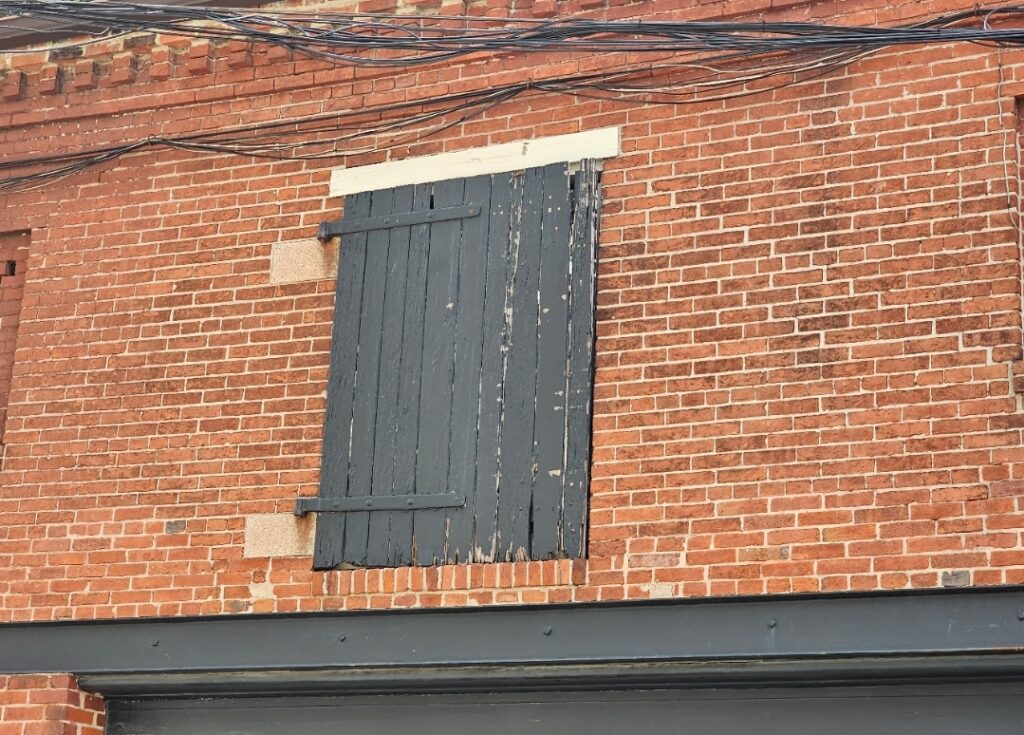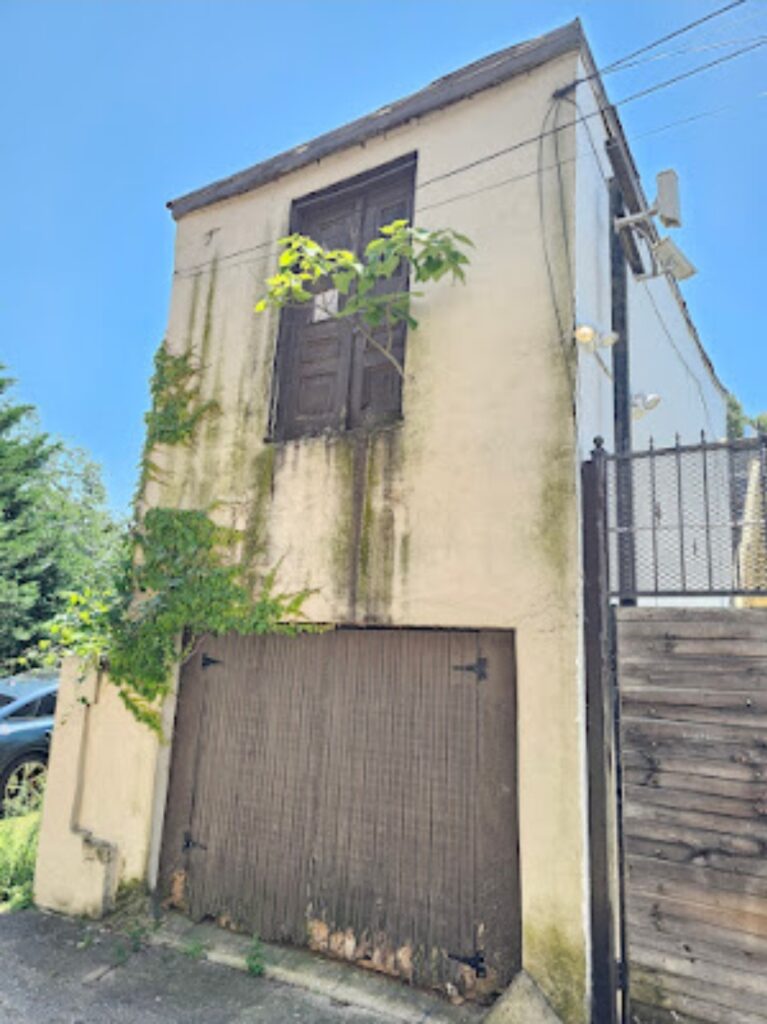Today, we’re starting a multi-part series on hay doors (and lucarne doors). Hay doors are a historic relic that have survived, in some rare and few cases to modern times. The overall conversation is very interesting and gets into many other related topics such as ADU and accessory buildings, and the accelerated deterioration of accessory buildings even though they are built with similar materials and methods as historic row homes. The conversation also goes into the areas of optimization of property use and zoning related to ADU’s here in Washington DC.
An example of an urban alley building with a hay door is shown below. Hay doors and pulleys (also known as gin wheels, in certain cases) allowed for easy lifting of hay bales to the upper levels. People who managed horses, often called grooms or stable hands, could use ropes and pulleys to hoist heavy bales, reducing the physical strain and making the process more efficient.
It’s likely that this alley building was originally built as a stable, similar to a barn. In historic times before cars were widely used, people used horses, literally right here in Washington DC. To have a horse here in the city you needed a place to keep that horse and you needed a mezzanine or attic space above to store feed for that horse such as hay and grain and other materials related to upkeep and care of the horse or animals. Hay doors were built in barns and similar buildings, like the one shown here, in historic times primarily for practical reasons related to this storage and animal care. The upper level of these buildings, often referred to as a hayloft, was used to store hay and these other materials.
The upper levels provided a large, dry area for storage, keeping these food stores and materials off the ground where they could get wet and spoil. Utilizing vertical space maximized storage capacity in a limited footprint. This is a concept we are constantly dealing with here living in a densely built city like Washington, DC. Whether it’s a house or a garage, we always want more space, and creative ideas like using the upper levels above the main floor of a garage are innovative and effective. Storing hay in the loft space protected it from moisture and pests, which helped preserve its quality for feeding livestock throughout the long and bitter DC winters when growing more locally or replenishing supplies wasn’t always a practical option. Today, these same Loft spaces can be used as granny sweets or home offices, or even home exercise or meditation rooms.
Hay stored above could be easily dropped down to the animals in the stalls below, using gravity to move the hay, which made the work a bit more efficient and reduced a bit of strain from the labor. As well, keeping hay separate from the animals reduced the risk of fire spreading. Hay is highly flammable, and storing it above and away from other combustible materials and sources of ignition (like lanterns or machinery) was safer. Even though animals don’t need lighting in their stable space, workers such as stable hands would have to tend to these animals, even at times when the sun was down and it was dark outside. Here in Washington, DC the sun goes down before 5:00 p.m. at parts of the winter so it’s dark out even before the work day is done.
Electricity for lighting and household convenience began to be used in cities like Washington, D.C. in the late 19th century. The widespread use of electric lighting can be traced back to the 1880s. Thomas Edison’s development of the practical incandescent light bulb in 1879 played a crucial role in making electric lighting feasible for widespread use.
In Washington, D.C., electric street lighting was introduced in 1881, and by the late 1880s and early 1890s, electric lighting was becoming more common in homes and businesses. The introduction of electrical infrastructure, such as power plants and distribution networks, facilitated the transition. For instance, the Edison Electric Light Company established the first central power station in the United States in New York City in 1882, and similar developments soon followed in other cities, including Washington, D.C. By the turn of the century, electricity was increasingly available in urban areas, transforming daily life with electric lighting and other household conveniences.
Surprising to most people today though, at the time that most historic brick buildings were actually built in DC, people were still often using candles and lanterns for lighting (in the early 20th century). While electricity was becoming more widespread, its adoption was gradual and not yet universal at the start of the century. Some historic buildings here in Washington DC still have remnants of the historic gas lights left behind. Even in many cases where the building owners aren’t aware of the historic infrastructure, when we do work to repair the buildings, we will often find remnants of the gas piping, originally used for gas lighting.
The electrical infrastructure, such as power plants and distribution networks, was still being developed and expanded. Not all areas, especially rural and less affluent neighborhoods, had immediate access to electricity. The cost of installing electrical wiring and fixtures could be prohibitive for some households. Additionally, the ongoing expense of electric service was a consideration for many families. Early electrical service was often limited to certain parts of a city. Peripheral areas, smaller homes, and older buildings might not have had access to electricity until later. As well, early electrical systems were not as reliable as they are today. Outages and inconsistent service could lead people to continue using candles and lanterns as a backup or even primary source of lighting. By the 1920s and 1930s, electricity had become more reliable, affordable, and widely available, leading to a significant decline in the use of candles and lanterns for everyday lighting in urban areas like Washington, D.C. However, in the early 20th century, it was still common to see a mix of electric and traditional lighting methods. For these reasons, it was safer to store large quantities of hay bales up in a hayloft instead of on the ground level.
If you’ve read some of our past blog articles, you may be aware that one of the major reasons brick masonry was used so prolifically in the construction of dense urban centers like here in Washington, DC, in historic times. That historic brick has an innate natural characteristic to resist and deter the spread of fires. Here, looking at the hayloft and the historic remnants of these spaces, left over and still visible in few places here in modern times, we can see the connection, all the way back to the historic times over 100 years ago.
In this coming week’s article on part two of this series we’ll talk about why the historic brick masonry accessory buildings are built with similar methodologies and materials, yet in many cases have deteriorated much more drastically.
We can Help
Our company focuses on historic restoration more than modern building upkeep, maintenance and construction, but our company understands both types of construction very well and a full picture well-rounded approach is needed in any niche in the construction industry. Although we focus on historic restoration, repointing, tuckpointing and historic brick repair, our company also has technical knowledge and competencies in the areas of modern and contemporary construction as well as we become one of the leaders in that area of the market today. Understanding both historic and modern or contemporary construction is useful because both aspects help understand the challenges and potential solutions for challenges in building science and construction.
We can help with a variety of historic masonry restoration needs and upkeep, from modest tuckpointing and or repointing to complicated and extensive historic masonry restoration. Infinity Design Solutions is a historic restoration specialist contractor specializing in both historic masonry restoration such as tuck pointing our repointing, and brick repair. If you have questions about the architectural details or facade of your historic building in Washington DC, reach out and say hello and if we can help we’ll be glad to assist you. You can email us or call us on the telephone at the following link: contact us here.


